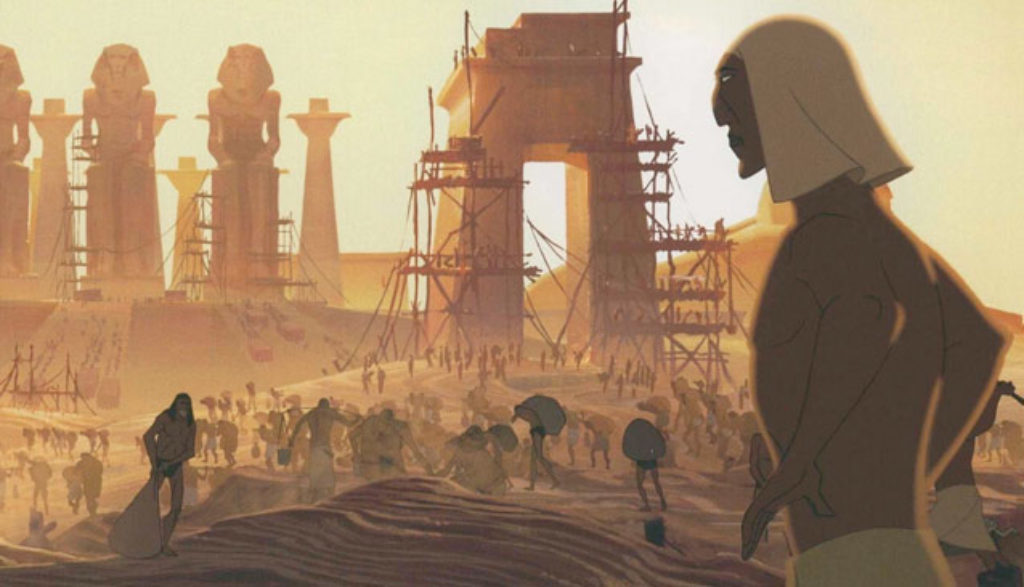
Prince. Prophet. Patriarch. … Prankster?
While DreamWorks’ tale of Moses’ life may stray occasionally from the chapter-and-verse account found in Exodus 1-14, The Prince of Egypt reverently brings biblical history back to the big screen. Not since 1956, when Charlton Heston led more than 25,000 robed extras through the Red Sea and into the hearts of moviegoers, has cinema celebrated the stuff of Sunday-school lessons with such remarkable style and energy.
Featuring Val Kilmer, Ralph Fiennes, Sandra Bullock, Michelle Pfeiffer and other recognizable voices, the animated Prince of Egypt showcases first-rate talent at every turn. The film includes songs by Disney lyricist Stephen Schwartz (Pocahontas) and a musical score composed by Hans Zimmer (The Lion King). More than 350 animators, artists and technicians spent the last four years immersed in the Old Testament. It shows.
Prince of Egypt opens with God’s people slaving under Egyptian oppression, praying in song for their deliverance. After a thrill-packed water ride in a basket, the infant Moses is plucked from the river by Pharaoh’s wife to be raised as a brother of Rameses. The boys share a close bond. Moses is playfully prankish, much to the chagrin of his brother who usually gets blamed (“One weak link can break the chain of a mighty dynasty,” Pharoah chides Rameses).
Lightheartedness gives way to somber soul-searching when, outside the palace, Moses’ sister confronts him with his true identity and his destiny as Israel’s deliverer. In a brilliantly conceived dream sequence, hieroglyphics drive that truth home, tastefully illustrating the dark edict and subsequent infanticide that threatened him as a baby. The next day, Moses confronts Pharoah, asking why scores of Hebrew infants were thrown to the crocodiles. The stern ruler replies, “Sometimes for the greater good, sacrifices must be made.” Moses’ reaction-a look of incredulity and disgust-sends a strong pro-life message all its own.
Soon after (in one of the film’s more egregious departures from Exodus), Moses “accidentally” kills an Egyptian and flees to Midian. There he marries Zipporah and, while tending sheep, finds himself drawn into God’s presence via the burning bush. Moses emerges with a steely determination to rescue his fellow Hebrews. The one man who stands in his way is Rameses, who has since inherited the throne and zealously refuses to become the “weak link” his father warned him about.
Plagues arrive in spectacular fashion. Frogs. Locusts. But the movie’s most chilling use of animation involves the final scourge—the Passover—drawn entirely in shades of gray except for the blood on Israel’s doorposts. After losing his first-born, Rameses reluctantly grants the nation its freedom, but pride inspires a change of heart. His army pursues Israel, leading to God’s miraculous parting of the Red Sea (an impressive sequence engineered for the screen by the computer effects wizards behind Twister). In the end, Moses and Rameses find themselves on opposite shores, divided by allegiances sprung from polarized hearts-one softened to the plight of slaves, the other hardened against God and His people.
“This is not a fairy tale that we could take and tell a ‘version’ of it,” studio head Jeffrey Katzenberg told Plugged In. “It was our goal and mandate to take this Bible story and tell it in its context as accurately as possible.” DreamWorks screened the movie for leaders of various faith communities to help accomplish that. Some theological suggestions impacted the final product. Others, however, were not negotiable. That creative license shouldn’t cause Christian families to reject Prince of Egypt as entertainment, but should serve as a warning not to let the film substitute for a thorough study of Scripture.
And what about mainstream audiences? Will they embrace this Prince? Perhaps, but scenes about infanticide and turning rivers into blood may not win over viewers raised on Walt Disney’s freewheeling approach to classic fairy tales. No wisecracking animals. No sly pop-culture references. The casting of Steve Martin and Martin Short as priests in Pharoah’s court promises comedic hijinks and witty banter, but with a few exceptions early on, they are humorless, foreboding characters who fail to deliver the comic relief unchurched viewers will be longing for in the film’s appropriately somber second half. Still, kudos to DreamWorks for not trivializing serious themes just to score a McDonald’s Happy Meal tie-in.
Prince of Egypt breathes color and life into key milestones on Israel’s journey to freedom. Beyond its biblical subject matter, this visually stunning movie combines eye-popping effects with Monet-inspired backdrops. If such technical excellence can attract crowds and create an interest in the original text, The Prince of Egypt could become this generation’s The Ten Commandments.
